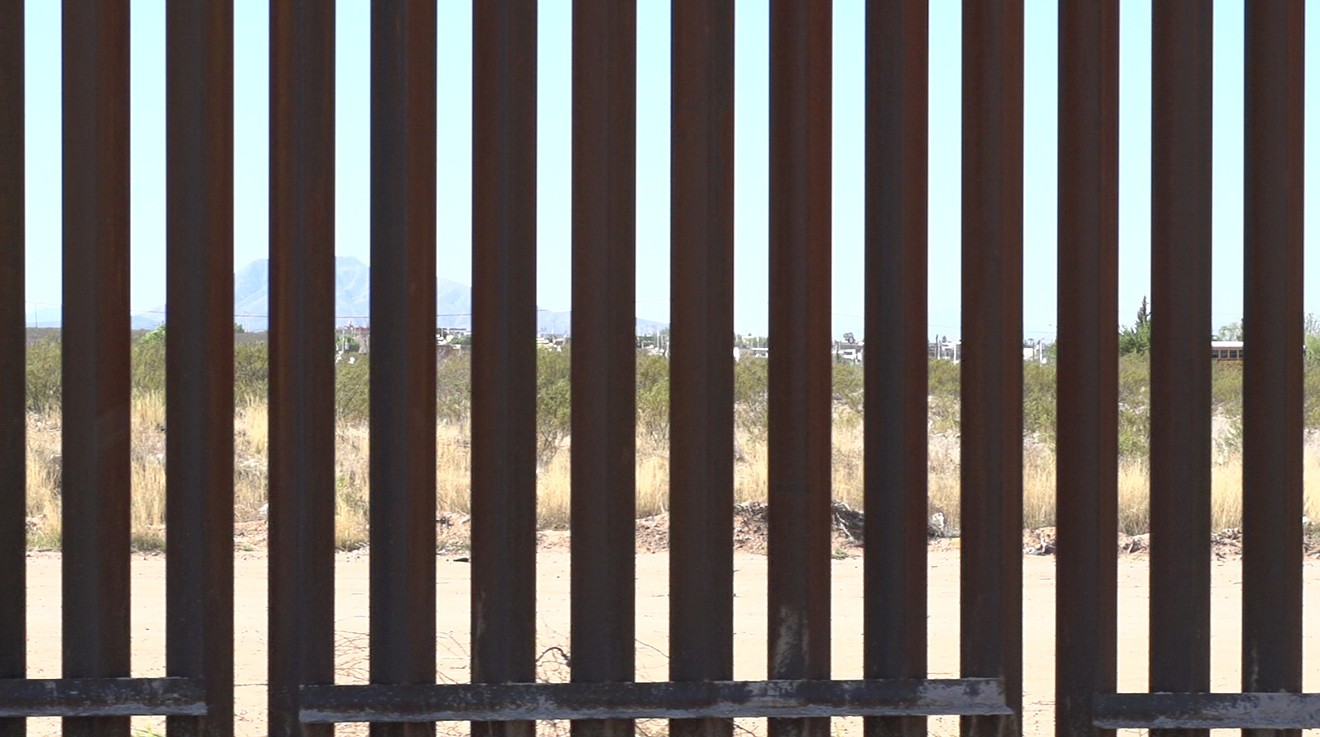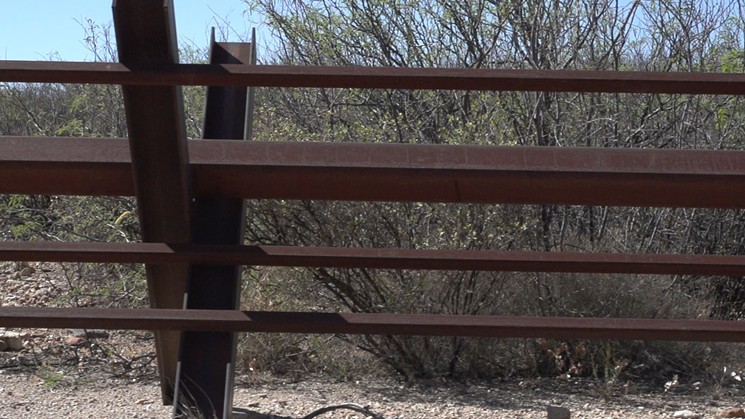Trump's pronouncement reflects the us-versus-them mentality that's so prevalent in border-related discourse these days. It's precisely the sort of either/or thinking the Southwest art collective Postcommodity works to dispel.
One of Postcommodity's works, a four-channel video with sound titled A Very Long Line, is featured in the 2017 Whitney Biennial. The prestigious exhibition runs through June 11 at the Whitney Museum of American Art in New York City.
A Very Long Line is one of the biennial's most powerful works. That's because it addresses border-related issues head on, with indigenous voices that set the immigration debate within the context of colonization and commodification of people and goods moving through the borderlands.

Postcommodity artists Raven Chacon, Cristóbal Martínez, and Kade L. Twist.
Courtesy of Postcommodity
One large-scale painting by Brooklyn-based Aliza Nisenbaum depicts a gathering of undocumented immigrant women. An installation with thousands of adobe bricks by Los Angeles artist Rafa Esparza references the relationship between laborer and land. Vietnam-based Tuan Andrew Nguyen, familiar to many for his work with The Propeller Group, explores refugee experiences and displacement using ultra-high-definition video.
Postcommodity creates work within the borderlands, capturing the region's historical and contemporary complexities. In doing so, they weave a compelling counternarrative to simplistic, ideological views of the border.
The collective, which was founded in 2007, brings together three indigenous artists.
Raven Chacon is an Albuquerque-based artist who hails from the Navajo Nation. Cristóbal Martínez is a Mestizo artist based in Mesa. Kade L. Twist is a Santa Fe-based artist and enrolled member of the Cherokee Nation of Oklahoma. Together, they explore colonization within contemporary society.
A Very Long Line, which was previously shown at the Center for Contemporary Arts in Santa Fe, New Mexico, surrounds viewers with images captured along a portion of the border between Douglas, Arizona, and Agua Prieta in Sonora, Mexico.
Viewers see three variations of border fences, along with surrounding neighborhoods and landscapes. But the images travel past them at varying speeds, prompting a disorienting feeling. It’s heightened by a discordant soundtrack, created by Postcommodity using hacked instruments and other objects.
Filmed while the artists drove parallel to the border with a camera mounted on top of their vehicle, A Very Long Line couldn’t be more relevant. That’s because immigration and border-related issues are hot topics in the current politically charged climate. But they're far too complex for 60-second sound bites or 140-character blurbs.
Postcommosity takes a different approach.
By creating a work comprising actual images of the borderlands, they bring the physical space into clearer focus. The borderlands aren’t an abstraction. They’re home to people, plants, and wildlife. And they’ve long been traversed by indigenous people, who migrated freely in many a time past.
Of course, A Very Long Line does far more than document a small section of the U.S.-Mexico border. It captures the deep complexity of border-related issues, via unsettling pacing and noise components. Hence, it prompts reflection on deeper questions about commodification, colonization, and contemporary culture.
They’re prevalent themes in Postcommodity’s larger body of work, which includes their 2017 Coyotaje installation for Brooklyn’s Art in General gallery. Using an inflatable sculpture, closed-circuit night vision video, sound, and photograph, the collective explores ways border patrol agents use indigenous knowledge against those seeking to cross the border under cover of darkness.
To date, Postcommodity’s best-known work is a temporary installation called Repellent Fence. It bisected part of the U.S.-Mexico border in October 2015. And it’s featured in a documentary film titled Through the Repellant Fence: A Land Art Film, which was screened in April at Scottsdale Museum of Contemporary Art.

Postcommodity bisected the U.S.-Mexico border with 26 balloons for its Repellent Fence.
Courtesy of Postcommodity
By including Postcommodity's work in the Whitney Biennial, curators have affirmed the critical role indigenous artists play in fostering conversations that embrace the full depth and breadth of borderland histories and immigrant lives.
The Whitney Biennial continues through June 11 at the Whitney Museum of American Art in New York City. Find more information on the Whitney Biennial website.
Editor's note: This post has been updated from its original version.














